National Depression Glass Association
Preserving America's Glass Manufacturing Heritage
Glassware was different in the Depression years
by David Adams
As a glass collector, have you ever wondered why there are so many Depression era wine glasses that don't hold much liquid? Have you ever thought about why the tall goblets in many
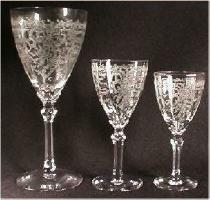 patterns are referred to as "water goblets"? Have you considered the number of "mayonnaise" sets there seem to be? What about nut cups and cream soups? Why are there items that you never see for sale today?
patterns are referred to as "water goblets"? Have you considered the number of "mayonnaise" sets there seem to be? What about nut cups and cream soups? Why are there items that you never see for sale today?
Let's take a closer look into what was happening during the years of the Great Depression in the United States, which extended from October 1929 until the early years of World War II.
One of the main influences on glassware design, at least during the early years of the Depresion, was the existence of the 18th Amendment, better known as "Prohibition." The sale of alcoholic beverages was prohibited, but, oddly enough, the consumption of alcohol was not! In fact, during Prohibition, making alcohol at home was very common and legal (up to 200 gallons per year). Stores sold grape concentrate with warning labels that listed the steps that should be avoided to prevent the juice from fermenting into wine.
The glass companies sold stemware during those years, but were careful to use terminology which made it appear that one wouldn't be using it for illegal purposes. So, the tall goblet was called the water goblet, while the wine was typically much smaller (2 to 3 ounces) and was for "medicinal purposes" only, or perhaps for "sacramental" wine. To illustrate, the photo at right shows three sizes of Fostoria stemware, the goblet, claret and wine.
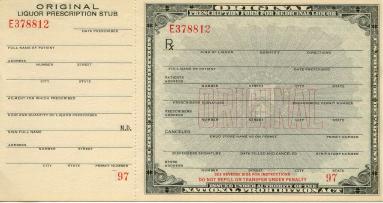 At left, you can see an example of the prescription form that a doctor could use to prescribe "medicinal" alcohol. And just to add some color to this article,
At left, you can see an example of the prescription form that a doctor could use to prescribe "medicinal" alcohol. And just to add some color to this article,
 I'm including a sign (at right) from the front window of a closed "speakeasy" from the early 1930s.
I'm including a sign (at right) from the front window of a closed "speakeasy" from the early 1930s.
Everyone knows about the rowdy days of Prohibition, where the gangsters reigned supreme, "bootleggers" souped up their automobiles to be able to outrun the "revenuers" so they could sell their "moonshine" and in the process, became the origins of NASCAR racing of today. Eventually, the "great experiment" of Prohibition had to come to an end (as did Al Capone), and the 21st Amendment to the Constitution was passed in 1933, repealing the 18th and ending the era of Prohibition. Many of the glass companies celebrated by releasing "Repeal" glassware sets – stemware and barware, which might explain why there are so many "decanters" from that time frame.
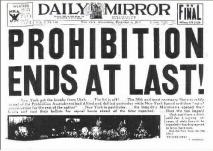 So, what else about those times influenced the terminology of glassmaking that sometimes confuses us today? How about all of those "nut cups" you see in dealers' booths? What in the world was that all about?
So, what else about those times influenced the terminology of glassmaking that sometimes confuses us today? How about all of those "nut cups" you see in dealers' booths? What in the world was that all about?
You may have heard the expression "soup to nuts." It referred to a formal dinner, where the first course that was served to guests was a soup course, and at the end of the meal, the last
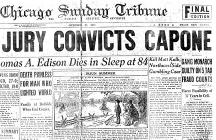 thing served was a small dish containing nuts (usually almonds). The glass companies were always eager to produce something that would sell, and so they made nut cups to match the glass dinnerware that was popular at the time. There seems to have been a special piece of glass for nearly every purpose.
thing served was a small dish containing nuts (usually almonds). The glass companies were always eager to produce something that would sell, and so they made nut cups to match the glass dinnerware that was popular at the time. There seems to have been a special piece of glass for nearly every purpose.
Collectors sometimes confuse nut cups with "open salts." Actually, the open salts were from an earlier era, before salt was refined so that its grains were small enough to go through the holes of a salt shaker. By the time of the Depression era, salt shakers were in common use and the old "open salts" were a thing of the past.
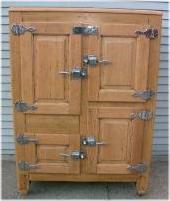 In those formal dinners I mentioned, one was careful to serve the soup course in the correct container. A "cream soup" was a two-handled bowl, usually paired with a liner or underplate, while a "clear soup" or "boullion" was smaller, often about the size of a teacup, and also two-handled and paired with a liner that was usually a saucer. Eventually, flat soups replaced both pieces and were used for either kind interchangeably.
In those formal dinners I mentioned, one was careful to serve the soup course in the correct container. A "cream soup" was a two-handled bowl, usually paired with a liner or underplate, while a "clear soup" or "boullion" was smaller, often about the size of a teacup, and also two-handled and paired with a liner that was usually a saucer. Eventually, flat soups replaced both pieces and were used for either kind interchangeably.
Now let's consider all of those "mayonnaise" sets you see at the shows. During the early part of the 20th Century, mayonnaise was not readily available in stores – you had
to make it yourself. Furthermore, most of the United States was still without electricity, and homes instead had ice boxes like the one pictured at left. The ice man delivered block ice, which went in the upper compartment and kept the food cold until it melted. So it would have been difficult to keep mayonnaise for any length of time, as it would likely have spoiled in
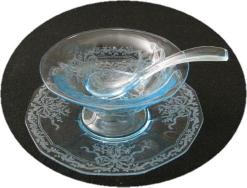 the ice box. The glass companies provided a very nice bowl, glass spoon and liner (example at right) for you to serve the mayonnaise that you made for yourself in the kitchen.
the ice box. The glass companies provided a very nice bowl, glass spoon and liner (example at right) for you to serve the mayonnaise that you made for yourself in the kitchen.
When you study the glassware that you collect, you inevitably have to consider the times as well. Glass companies were largely located in Pennsylvania, West Virginia and Ohio, but not by chance. There were three very important things that determined where one would locate a glass company: transportation, fuel and raw materials. There are deposits of the right type of sands in those three states, the Ohio river and its tributaries run past many of the glass companies, providing barge transportation for large quantites of sand and other raw material, and finally, that area of the country had sustainable deposits of natural gas, used to fuel the furnaces, which were always on. Railroads were used to transport the finished goods and all the factories had a railroad siding. Trucking was not yet the mode of transportation that it has become in today's world.
There is an apocryphal story that one glass company was saved from bankruptcy during the Depression when Quaker Oats ordered five railroad cars worth of glass to be used as premiums in their cereal. Soap manufacturers often gave away glass in boxes of their products. The "hook" was the premium – you could then buy more items in the same pattern at your local grocery store. The glass companies loved this type of promotion.
One last item I will mention, being very related to the "times" that the glass was produced.
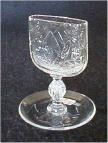 In those days, it was quite fashionable to offer your guests a cigarette and the glass companies made a special piece of glass for this purpose. You'll find cigarette boxes and cigarette urns, and those interesting stemmed and footed pieces that all the glass dealers use to hold their business cards. Those are "cigarettes" – notice the upturned foot which could be used as an ash tray. Imagine what your guests would think today, if you offered them a cigarette from a glass dish on the coffee table! Instead, we use them as card holders, or the boxes as a decorative piece to hold jewelry on the dresser.
In those days, it was quite fashionable to offer your guests a cigarette and the glass companies made a special piece of glass for this purpose. You'll find cigarette boxes and cigarette urns, and those interesting stemmed and footed pieces that all the glass dealers use to hold their business cards. Those are "cigarettes" – notice the upturned foot which could be used as an ash tray. Imagine what your guests would think today, if you offered them a cigarette from a glass dish on the coffee table! Instead, we use them as card holders, or the boxes as a decorative piece to hold jewelry on the dresser.
Starting a collection of "depression glass" is a great way to get children to learn about what things were like in our country at the time the glass was made. Encourage your children to take an interest in the glass, and to ask questions of the dealers at the shows. Have them try to find out more about the company that made the glass and what things were like back then. They might be surprised to discover that the glass companies hired boys to work in the factories (they required less in wages).
The NDGA web site has some interesting old advertisements interspersed with the glass information, showing some of the products (and their prices) that were being marketed at the time our collectible glass was being manufactured. Take a trip down memory lane, to a time when there was no "dial" on a telephone (dial, what's that?). Check out the automobiles and refrigerators and other items that look so different today.
You can use your "depression glass" as a great learning tool. And, at the same time, you can set a beautiful table for your family and guests. Be sure to put out that "mayonnaise" set and a couple of nut cups. But forget the cigarette holder…